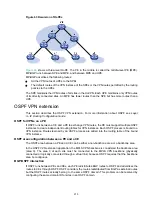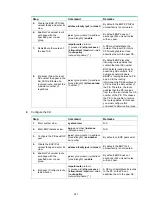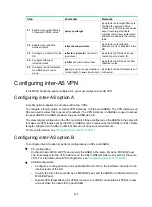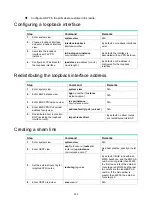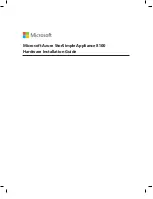
224
Step Command
Remarks
8.
Filter routes received from or
advertised to a peer or peer
group based on an AS_PATH
list.
peer
{
group-name
|
ipv4-address
[
mask-length
] }
as-path-acl
aspath-filter-number
{
import
|
export
}
By default, no AS filtering list is
applied to a peer or peer group.
9.
Advertise a default VPN
route to a peer or peer group.
peer
{
group-name
|
ipv4-address
[
mask-length
] }
default-route-advertise
vpn-instance
vpn-instance-name
By default, no default VPN route is
advertised to a peer or peer
group.
10.
Apply an ACL to filter routes
received from or advertised
to a peer or peer group.
peer
{
group-name
|
ipv4-address
[
mask-length
] }
filter-policy
ipv4
-
acl-number
{
export
|
import
}
By default, no ACL-based filtering
is configured.
11.
Save all route updates from a
peer or peer group.
peer
{
group-name
|
ip-address
[
mask-length
] }
keep-all-routes
By default, BGP does not save
route updates from any peer.
12.
Specify the router as the next
hop of routes sent to a peer
or peer group.
peer
{
group-name
|
ipv4-address
[
mask-length
] }
next-hop-local
By default, the router sets itself as
the next hop for routes sent to a
peer or peer group.
13.
Configure BGP to not
change the next hop of
routes sent to a BGP peer or
peer group.
peer
{
group-name
|
ipv4-address
[
mask-length
] }
next-hop-invariable
By default, the router sets itself as
the next hop for routes sent to a
BGP peer or peer group.
In an inter-AS option C network
where an RR is used to advertise
VPNv4 routes, configure this
command on the RR so the RR
does not change the next hop of
routes sent to BGP peers and
clients.
14.
Set a preferred value for
routes received from a peer
or peer group.
peer
{
group-name
|
ipv4-address
[
mask-length
] }
preferred-value
value
By default, the preferred value is
0.
15.
Apply a prefix list to filter
routes received from or
advertised to a peer or peer
group.
peer
{
group-name
|
ipv4-address
[
mask-length
] }
prefix-list
prefix-list-name
{
export
|
import
}
By default, no prefix list based
filtering is configured.
16.
Configure BGP updates
advertised to an EBGP peer
or peer group to carry only
public AS numbers.
peer
{
group-name
|
ipv4-address
[
mask-length
] }
public-as-only
By default, BGP route updates
advertised to an EBGP peer or
peer group can carry both public
and private AS numbers.
17.
Configure the device as an
RR and specify a peer or
peer group as its client.
peer
{
group-name
|
ipv4-address
[
mask-length
] }
reflect-client
By default, no RR is configured.
18.
Allow the RR to send routes
received from a peer or peer
group to its clients.
peer
{
group-name
|
ipv4-address
[
mask-length
] }
reflect-route
By default, an RR can send
received routes to its clients.
19.
Set the maximum number of
routes BGP can receive from
a peer or peer group.
peer
{
group-name
|
ipv4-address
[
mask-length
] }
route-limit
prefix-number
[ {
alert-only
|
discard
|
reconnect
reconnect-time
} |
percentage-value
] *
By default, the number of routes
that BGP can receive from a peer
or peer group is not limited.
20.
Apply a routing policy to a
peer or peer group.
peer
{
group-name
|
ipv4-address
[
mask-length
] }
route-policy
route-policy-name
{
export
|
import
}
By default, no routing policy is
applied to a peer or peer group.

